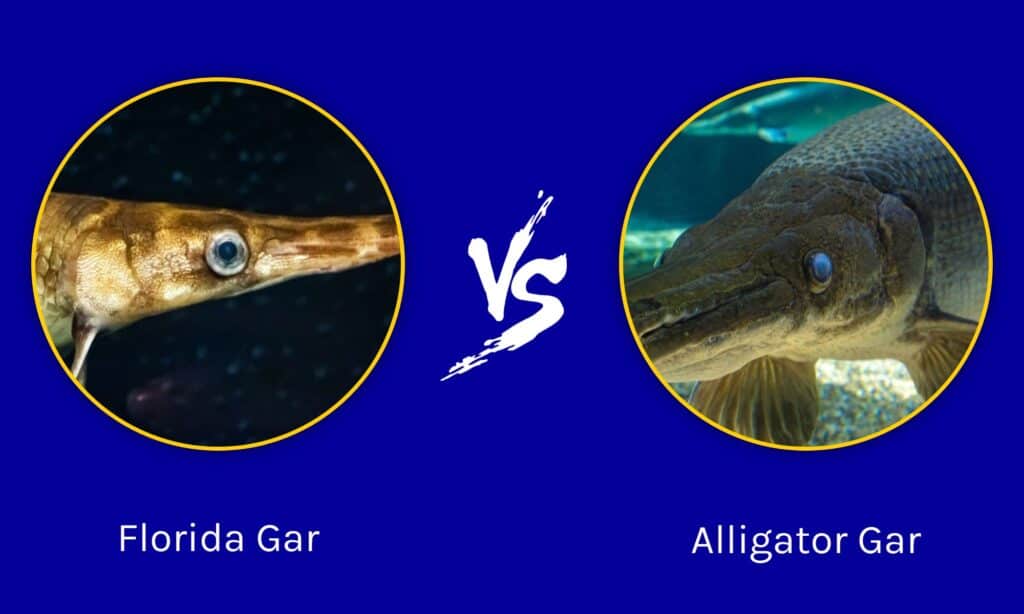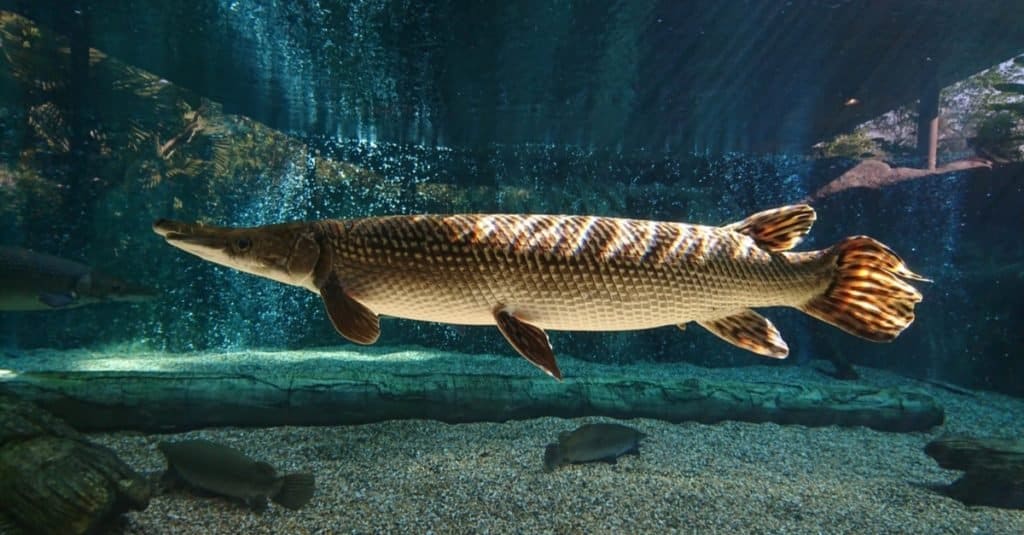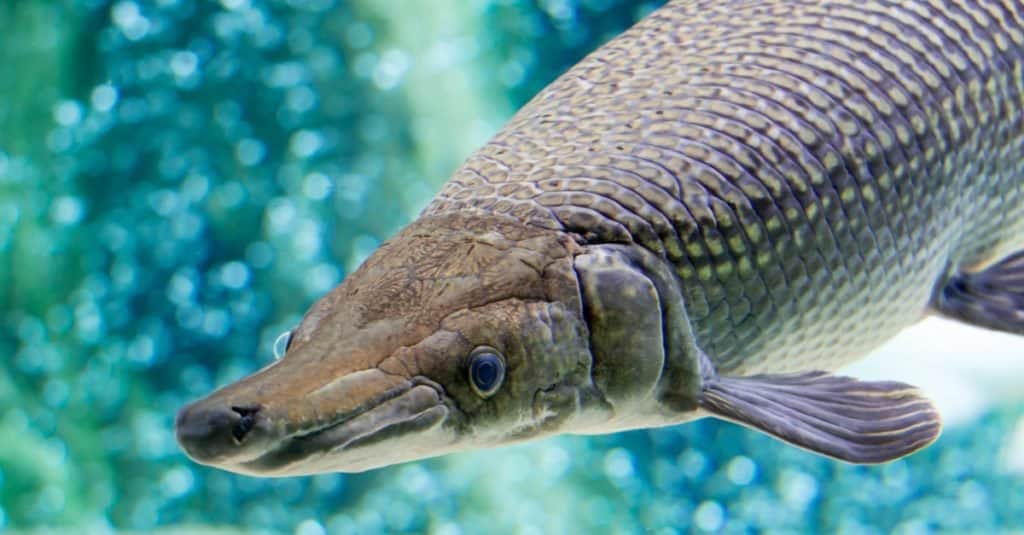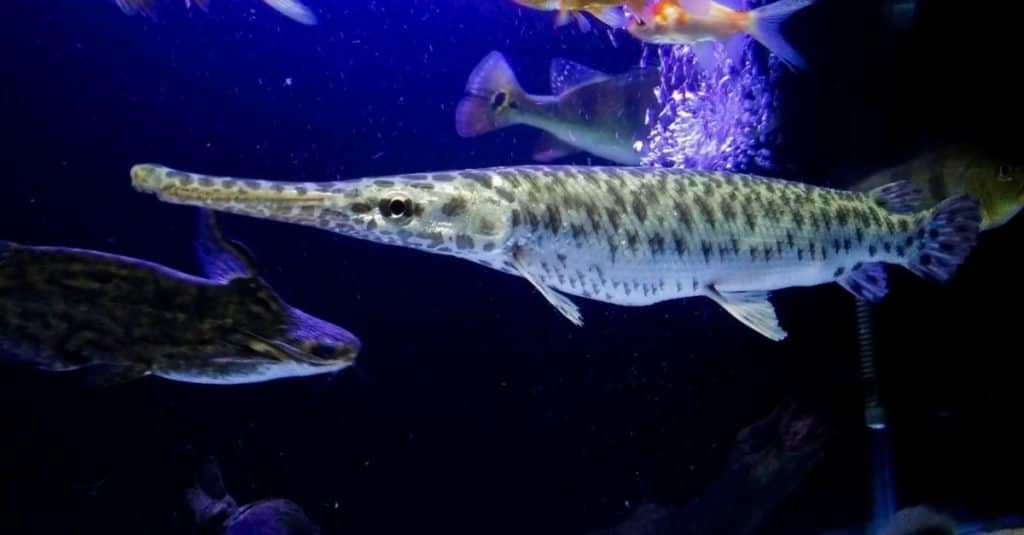Gars are unique, torpedo-shaped fish that stem from a family of ray-finned fish that date back over 157 million years. Modern gars are only found in the Americas, especially the eastern United States and Central America. However, their ranges overlap greatly, and they tend to look alike. That’s why we’re going to take a look at the Florida gar vs alligator gar and show you how to tell each one of these creatures apart from the other.
Comparing a Florida Gar and an Alligator Gar

| Florida Gar | Alligator Gar | |
|---|---|---|
| Size | Weight: 3 to 10 pounds Length: 1.8 to 4.4 ft | Weight: 100 to 350 pounds Length: 6 to 10 ft |
| Morphology | – Torpedo-shaped body – Long, thin snout with rows of teeth – May be gray or light olive with dark, diamond-shaped, or roundish dorsal scales – Light gray or whitish ventral scales | – Large and thick body – Long, wide snout with rows of teeth – Often brown or dark green with light colors on ventral scales |
| Range | – Florida, USA – From the Ochlocknee River and eastward in Florida – Prefer to live in streams, lakes, and canals | – Rivers and waterways along the Mississippi River – Found in Texas, Louisiana, Mississippi, Alabama, Arkansas, Missouri, Illinois, Oklahoma, and more |
| Diet | – Shrimp, insects, fish, and zooplankton | – Fish, waterfowl, turtles, small mammals |
| Phylogenetic Name | – Lepisosteus platyrhincus | – Atractosteus spatula |
The 5 Key Differences Between a Florida Gar vs Alligator Gar

The alligator gar can get very large.
©Cheng Wei/Shutterstock.com
The greatest differences between a Florida gar and an alligator gar lie in their size and range. The alligator gar is a large fish, weighing between 100 and 350 pounds and measuring between 6 and 10 feet long. The Florida gar is a smaller fish weighing between 3 and 10 pounds while measuring about 1.8 to 4.4 feet in length. While the Florida gar is found almost exclusively in Florida, the alligator gar can be found in Texas, Louisiana, Arkansas, Illinois, and other states in the U.S.
These two differences highlight the chief ways to distinguish these creatures. However, we need to go in greater depth with each of their five differences to understand them better.
Florida Gar vs Alligator Gar: Size
The alligator gar is larger than the Florida gar. The average alligator gar measures between 100 and 321 pounds and measures about 6 feet long. However, the largest alligator gars can measure nearly 10 feet long and weigh over 300 pounds!
The Florida gar can weigh anywhere from 3 to 10 pounds and measures about 1.8 feet to 4.4 feet. They are much smaller in size than the alligator gar, the largest of the genus.
Florida Gar vs Alligator Gar: Morphology

The alligator gar has a wider snout than the Florida gar.
©Bill Roque/Shutterstock.com
Aside from size, you can tell these creatures apart based on their body and color. Both creatures are torpedo-shaped and have an elongated snout. However, the Florida gar’s snout is much thinner than the alligator gar’s snout.
The alligator gar also has a very thick body compared to the Florida gar. Alligator gars are known for having various shades of brown and green as their dorsal scale colors. They may have some black scales mixed into their main color, too. Also, they have a light color like crème, white, or yellow on their ventral scales.
The Florida gar will be gray or light olive, and they will have many dark, diamond-shaped, or round dorsal scales. They also have a whitish underbelly. Based on the color differences between these fish and the prevalence of spots, you can usually tell the difference between the two gars.
Florida Gar vs Alligator Gar: Range
The alligator gar is found in more places than the Florida gar. As the name suggests, the Florida gar is from Florida. The fish is only found in this state, though some potential sightings have occurred in other areas.
However, the alligator gar is far more widespread. This fish can be found all along the Mississippi River and surrounding waterways. The alligator gar is found in the lowest parts of the U.S. and all the way to the central parts of the U.S. This fish is found in places like Texas, Louisiana, Mississippi, Alabama, Oklahoma, and more.
Florida Gar vs Alligator Gar: Diet
The alligator gar and the Florida gar have different diets because they live in different areas. The Florida gar is known for snacking on things like shrimp, insects, fish, and zooplankton. However, the alligator gar is known to eat fish, waterfowl, turtles, and small mammals.
The alligator gar is a much larger animal, so the chances are that it can eat larger prey without a threat to itself. These animals both attack as stealth predators underwater, so it’s not that often that humans capture their feeding habits on film. Thus, we don’t know how precisely how big they prefer their prey.
Florida Gar vs Alligator Gar: Phylogenetic Name

The Florida gar belongs to a different genus than the alligator gar.
©Oyek Photo/Shutterstock.com
Lastly, we can see the differences between the Florida gar and the alligator gar by looking at their names. The Florida gar is officially known as the Lepisosteus platyrhincus, and the alligator gar is Atractosteus spatula. As you can see, the two stem from different genera, but they are related on the family level.
Both of these fish come from the Lepisosteidae family. However, they are very different at the genus and species levels.
The alligator gar and the Florida gar are two similar but distinct fish. The alligator gar is far more widespread since it is found in places throughout a dozen states in the U.S. Moreover, the alligator gar is far larger than the Florida gar. Even though the two belong to the same family, the size differences are vast. Not only can you tell these animals apart according to their size, but it’s also easy to see their differences in morphology.
The photo featured at the top of this post is © Andriy R/Shutterstock.com
Thank you for reading! Have some feedback for us? Contact the AZ Animals editorial team.






